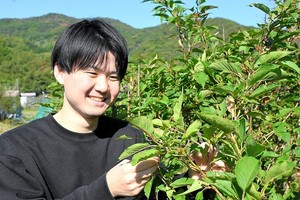By MASATO TAINAKA/ Staff Writer
August 2, 2024 at 18:51 JST
While the average age of atomic bomb survivors is 85-plus, members of younger generations are sharing their wishes and are taking action.
The student group "Know Nukes Tokyo" kicked off an augmented reality (AR) project on Aug. 1 in front of JR Shibuya Station. The "Know Nukes" experience turns users' smartphones into a digital window where a nuclear bomb falls on the Tokyo district.
“We want to visualize the threat of nuclear weapons. This is an issue for those of us living today,” said Suzuka Nakamura, a 24-year-old Sophia University student, who founded the group with friends after starting university.
This is not her first experience with activism. Nakamura is a third-generation hibakusha whose family is from Nagasaki.
In high school, she served as a peace ambassador to the United Nations' European headquarters where she delivered signatures calling for the abolition of nuclear weapons.
Nakamura admits the Know Nukes project is also a partial result of her frustration. After telling them about her peace-related efforts, peers would simply reply, "Wow, you are doing a great job."
This was encouraging, but she was disappointed they did not feel a call to action.
AN OCEAN'S WORTH
The group is not Nakamura's only anti-nuclear project. She also founded the free magazine "Ripples," which launched in April.
This was born from taking part in a program for cultivating entrepreneurs where her presentation garnered financial interest from business owners in their 30s and 40s.
Nakamura hopes to start a business of her own after graduation themed around peace.
“If entrepreneurs are connected with it, we may be able to create an ‘ecosystem’ for a sustainable peace movement,” she said.
The magazine's debut was accompanied by a pop-up event at a cafe in Tokyo's Shimokitazawa district.
The inaugural issue is split into two parts that were put together by Nakamura and Waseda University student Nonoka Koga, 23, who also plans on taking part in peace-themed efforts after graduating.
"What to eat in Nagasaki" makes up the lighthearted first half. The sightseeing guide is followed by more solemn articles that include the story of a woman who survived the atomic bombing.
As the title of the magazine suggests, Nakamura said she hopes she will act as a drop of water that creates a large ripple effect on society.
BEYOND CULTURE SHOCK
Many in Richland, Washington, remain proud of "the atomic bomb that ended the war."
The city's Hanford Site is a decommissioned nuclear production facility that was part of the U.S. government's Manhattan Project and produced plutonium for the bomb dropped on Nagasaki.
Richland High School is adjacent to it. "Home of the Bombers!" is splashed across the homepage of the school's website and its mascot is a mushroom cloud rising behind a capital "r."
This happens to be the school Koga attended for a study-abroad program when she was in high school.
Initially, she said she wore a hoodie with the emblem, because she wanted to be part of the school. But she stopped after she was saddened to learn that the school did not even teach about the damage caused by the atomic bombing.
Before returning to Japan in 2019, she took part in the school video, asking fellow students, "Should we have pride in killing innocent people?"
The story was picked up by the Tri-City Herald and Japanese media also interviewed her.
One atomic bomb survivor in Hiroshima was moved by Koga’s action.
Toshiharu Goto, 85, was a first-year student at a national school when he was caught in the blast in a hallway. At one point, he was trapped under the school building.
He said he was surprised that “a Japanese high school student would criticize the atomic bombing in the place where the U.S. atomic bombs were manufactured,” after reading an article about Koga.
“You made a very brave statement,” he wrote in a letter to her. Koga would visit Goto three years later as a university student to produce a documentary on his life.
A screening was held in July at a cafe in Hiroshima with both in attendance.
After meeting Koga, Goto began to share testimonies about his experience.
“Her courage pushed me,” Goto said. “It makes me want to do my best for the world.”
At the screening, he told the audience, “As a survivor of the atomic bombing, I would like to live a long life and testify as much as possible that war is wrong and nuclear weapons should not be used.”
Koga has been researching about the Hanford Site, making it a subject of her graduation thesis, but she revealed at the event that she did not talk about her graduation thesis with friends while writing it.
She said she hesitated to discuss it because there is an image that only a few people are committed to the nuclear issue and bringing it up would be seen as “political.”
However, despite seeing people call nuclear abolition unrealistic and making fun of it, Koga said she is determined to press on and work as a freelance journalist to tell the world about atomic bomb survivors.
Like Nakamura, she hopes these stories will change the tides of perception and empathize with these issues.




















A peek through the music industry’s curtain at the producers who harnessed social media to help their idols go global.
A series based on diplomatic documents declassified by Japan’s Foreign Ministry
Here is a collection of first-hand accounts by “hibakusha” atomic bomb survivors.
Cooking experts, chefs and others involved in the field of food introduce their special recipes intertwined with their paths in life.
A series about Japanese-Americans and their memories of World War II